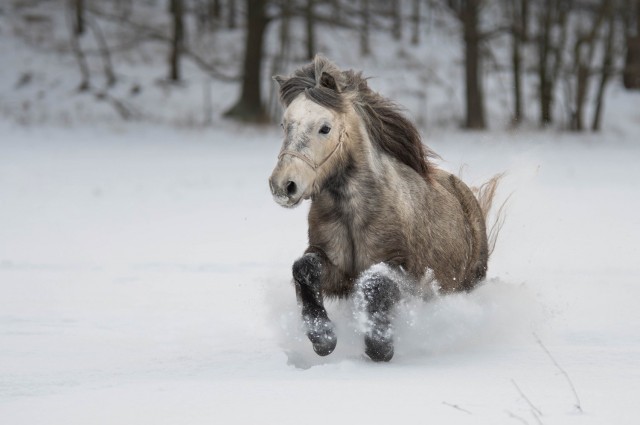FEEDING HORSES IN WINTER II.
Ing. Darina Havlíčková
Winter begins at the end of the calendar year and lasts until March. During this period of rest and short days, we should make sure that feed rations are lighter, while also providing the required nutrition and containing sufficient nutrients, trace elements and energy. Even if the horse works only lightly, you must ensure that it has enough minerals and vitamins ( Energys® PONY), the lower temperature must be taken into consideration when keeping horses outside, which means the addition of oil to the feed ration (Energys® OMEGA) and giving the horse moist mashes more often (Energys® NATURE range) rather than dry feed, as long as we can ensure that the feed will not freeze after it has been soaked.
Feeding horses in winter follows on to the recommendations set out in the article about “Feeding horses in autumn”. Just like in autumn, changes to management of feeding in winter apply to pastured, breeding or leisure horses, rather than sports horses. We need to increase the supply of dry matter and water at a similar ratio to grass when they are pastured for leisure and breeding horses. Various types of mash, whether complete (Energys® MASH), or mixed from individual ingredients (Energys® sugar-beet, alfalfa, spent grain, bran, etc.) are best. High-quality hay, ideally ad libitum (i.e. always available or as desired) is a matter of course, just as throughout the rest of the year. Haylage made from young grass or young alfalfa haylage is also very suitable in winter. Haylage is excellent winter feed. High-quality young haylage, processed for feeding to horses, is a full-value substitute for grazing in winter and supplies the horse with enough energy, proteins and trace elements. Unfortunately, it is more an exception than a rule to see high-quality haylage fed to horses in Czech stables. This is a great drawback in the Czech approach to feeding horses. The situation is the opposite to the west of our borders, where keeping breeding and sports horses has a much longer tradition. Most of the feed ration consists of haylage in these countries, with some hay, basically all year-round. Less labour required to harvest and a higher-quality and dust-free feed are clearly the advantages of haylage. The only condition that is harder to meet in our stables, is that there must be a sufficient number of horses to feed the bale of haylage to within 5 days. We can feed up to 10 kg/horse/day of halyage, which has 40% dry matter. This means that if we have 10 horses, we will feed approx. 100 kg a day and use a medium bale of haylage /approx. 400 - 500 kg) within this time limit quite easily. Then the only real requirement is the QUALITY of the haylage and every medium large stable has the potential to feed a bale within 4-5 days without any problems. If the haylage has more dry matter than 40 - 50%, it is much less suspect to secondary fermentation, freezing, etc, and retains its quality for longer. If it is chopped into longer lengths (at least 5 cm), it stimulates chewing quite well and is safe for the horses.
In the winter months, leisure and sports horses usually work less, which is why various detoxification, supporting and therapeutic treatment are suitable during this period (Energys® MASH, Energys® OMEGA GOLD, Energys® OMEGA, Milk thistle). We can give feeds that we could not offer during the sports season because they contain prohibited substances (herbs, spent grain, rice bran, etc.)
One excellent feedstuff for promoting proper shedding in all categories of horse towards the end of the winter period is the addition of whole or extruded flaxseed (Energys® OMEGA, Omega GOLD).
Horses have very limited access to pasture during the winter, and even if the winter is mild, you must count on the fact that the old grass that the horses graze on may have been frost-damaged or contain unsuitable herbs and plants. During this period, if the horses are outside for more than 2 hours, they should always have a sufficient amount of hay in the field with them. Hay provides them with constant access to fibre and offering them hay also discourages them from grazing on unsuitable grass or plants, which they would normally not eat and which could cause them digestive issues.
towards the end of the winter period, i.e. the beginning of March, sports horses can start to be fed the feed that we will feed during the sports season (Energys® STANDARD, EXTRA, muesli from the Energys® PREMIUM range) and more oats can be added. This means that in March, we will slowly begin to transition from extensive, supporting and lighter feed rations to rations that are more concentrated, provide more energy and contain more grains.
Photo Eliška Váchalová
